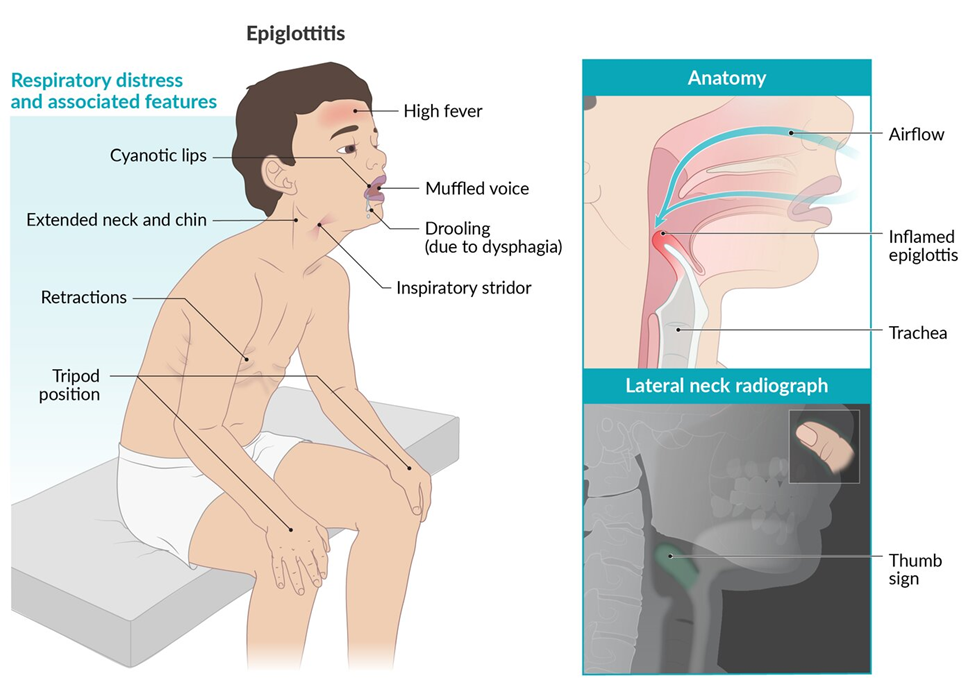A caregiver calls the pediatrician’s office and reports to the nurse that her 4-year-old, who was fine the previous day, complained of a sore throat early in the morning and now has a temperature of 102.6°F (39.2°C). The caregiver has tried to get the child to nap but the child gets panicky, sits back up, and leans forward with her mouth open and tongue out when the caregiver encourages her to lie down. The nurse suspects the child has which condition?
Epiglottitis
Mild asthma
Spasmodic laryngitis
Acute laryngotracheobronchitis
The Correct Answer is A
A. Epiglottitis:
Epiglottitis is an inflammation of the epiglottis, which can result in rapid onset of symptoms such as severe sore throat, high fever, and difficulty breathing. The characteristic position described, with the child preferring to sit up, lean forward, and keep the mouth open, is known as the "tripod position." This is a protective mechanism to maintain a patent airway.
B. Mild asthma:
Asthma is a chronic respiratory condition characterized by recurrent episodes of wheezing, coughing, and shortness of breath. However, the scenario does not describe typical asthma symptoms, and the child's preference for sitting up and leaning forward is more indicative of an airway obstruction.
C. Spasmodic laryngitis:
Spasmodic laryngitis is characterized by sudden episodes of severe respiratory distress, a barking cough, and sometimes stridor. It often occurs at night and is usually not associated with high fever. The child's behavior in the scenario, particularly the preference for sitting up and leaning forward, is not a common feature of spasmodic laryngitis.
D. Acute laryngotracheobronchitis:
Acute laryngotracheobronchitis, or croup, typically presents with a barking cough, stridor, and respiratory distress. It does not usually cause the preference for sitting up and leaning forward as described in the scenario. Croup is more commonly associated with a distinctive cough sound.

Nursing Test Bank
Naxlex Comprehensive Predictor Exams
Related Questions
Correct Answer is B
Explanation
A. Playing in an organized group with each other:
Toddlers typically engage in parallel play rather than organized group play. They may play near each other, but their interactions are often individual rather than coordinated in an organized group.
B. Playing independently and are side by side:
This is an accurate description of parallel play. Toddlers often play independently but are aware of and interested in what their peers are doing. They may play side by side without direct interaction.
C. Playing apart from others without being part of a group:
This option describes solitary play, where a child plays alone and does not actively engage with others. While solitary play is also common, parallel play is more characteristic of toddlers.
D. Playing together in an activity without organization:
This may describe a form of cooperative play, where children engage in an activity together. However, for toddlers, the organized aspect of play is less typical. Parallel play, where they play side by side but independently, is more common.
Correct Answer is C
Explanation
A. Calmly tell the child to stop:
While remaining calm is important, simply telling the child to stop might not be effective during a tantrum. Toddlers experiencing a meltdown might not respond immediately to verbal commands.
B. Distract the child by buying a toy:
Using material objects to distract a child during a tantrum might reinforce the behavior by rewarding it with something desired. It's also not always feasible to buy a toy instantly.
C. Appear to ignore them:
This strategy might involve not engaging directly with the tantrum, which could sometimes help to de-escalate the situation. However, it's crucial to ensure the child is in a safe environment and to offer support if necessary.
D. Place the child in time-out for 3 min:
Time-out can be a useful method for calming down a child. However, its effectiveness depends on the child's age, temperament, and the consistency of applying this method. Time-out might not be suitable for all children, especially for a 2-year-old who might not fully understand the concept.
Whether you are a student looking to ace your exams or a practicing nurse seeking to enhance your expertise , our nursing education contents will empower you with the confidence and competence to make a difference in the lives of patients and become a respected leader in the healthcare field.
Visit Naxlex, invest in your future and unlock endless possibilities with our unparalleled nursing education contents today
Report Wrong Answer on the Current Question
Do you disagree with the answer? If yes, what is your expected answer? Explain.
Kindly be descriptive with the issue you are facing.
